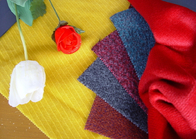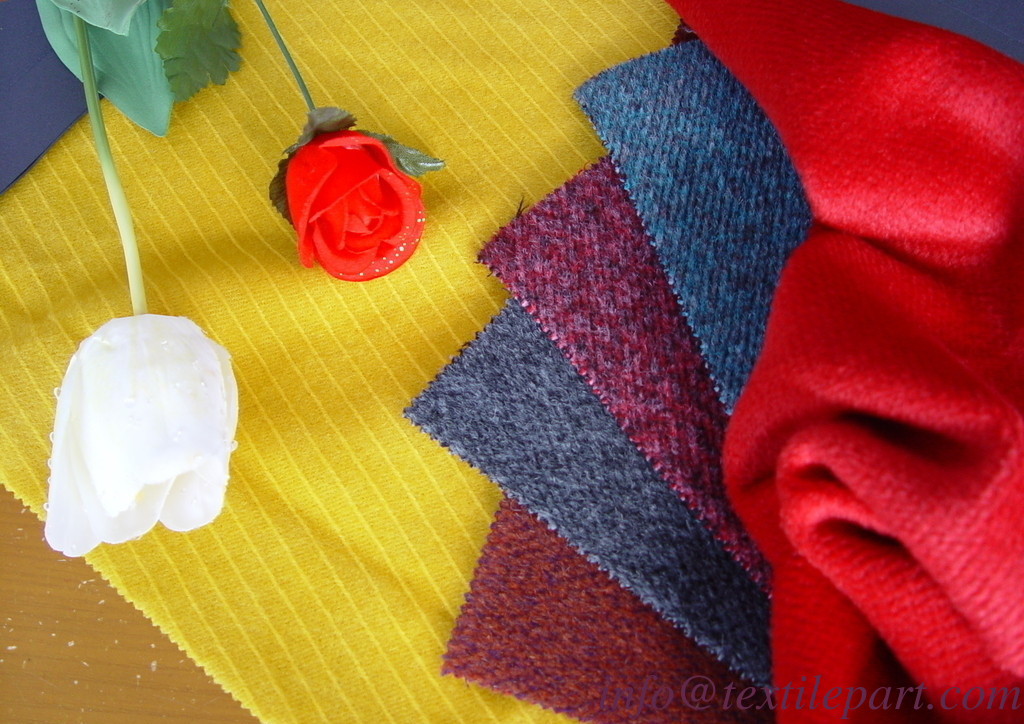Textiles can be made from many materials. These materials come from four main sources: animal (wool, silk), plant (cotton, flax, jute), mineral (asbestos, glass fibre), and synthetic (nylon, polyester, acrylic). In the past, all textiles were made from natural fibres, including plant, animal, and mineral sources. In the 20th century, these were supplemented by artificial fibres made from petroleum.
Textiles are made in various strengths and degrees of durability, from the finest gossamer to the sturdiest canvas. The relative thickness of fibres in cloth is measured in deniers. Microfibre refers to fibres made of strands thinner than one denier.
Animal textiles
Animal textiles are commonly made from hair, fur, skin or silk (in the silkworms case).
Wool refers to the hair of the domestic goat or sheep, which is distinguished from other types of animal hair in that the individual strands are coated with scales and tightly crimped, and the wool as a whole is coated with a wax mixture known as lanolin (aka wool grease), which is waterproof and dirtproof[citation needed]. Woollen refers to a bulkier yarn produced from carded, non-parallel fibre, while worsted refers to a finer yarn which is spun from longer fibres which have been combed to be parallel. Wool is commonly used for warm clothing. Cashmere, the hair of the Indian cashmere goat, and mohair, the hair of the North African angora goat, are types of wool known for their softness.
Other animal textiles which are made from hair or fur are alpaca wool, vicuña wool, llama wool, and camel hair, generally used in the production of coats, jackets, ponchos, blankets, and other warm coverings. Angora refers to the long, thick, soft hair of the angora rabbit. Qiviut is the fine inner wool of the muskox.
Wadmal is a coarse cloth made of wool, produced in Scandinavia, mostly 1000~1500CE.
Silk is an animal textile made from the fibres of the cocoon of the Chinese silkworm which is spun into a smooth fabric prized for its softness. There are two main types of the silk: 'mulberry silk' produced by the Bombyx Mori, and 'wild silk' such as Tussah silk. Silkworm larvae produce the first type if cultivated in habitats with fresh mulberry leaves for consumption, while Tussah silk is produced by silkworms feeding purely on oak leaves. Around four-fifths of the world's silk production consists of cultivated silk.
Plant textiles
Grass, rush, hemp, and sisal are all used in making rope. In the first two, the entire plant is used for this purpose, while in the last two, only fibres from the plant are utilized. Coir (coconut fibre) is used in making twine, and also in floormats, doormats, brushes, mattresses, floor tiles, and sacking.
Straw and bamboo are both used to make hats. Straw, a dried form of grass, is also used for stuffing, as is kapok.
Fibres from pulpwood trees, cotton, rice, hemp, and nettle are used in making paper.
Cotton, flax, jute, hemp, modal and even bamboo fibre are all used in clothing. Piña (pineapple fibre) and ramie are also fibres used in clothing, generally with a blend of other fibres such as cotton. Nettles have also been used to make a fibre and fabric very similar to hemp or flax. The use of milkweed stalk fibre has also been reported, but it tends to be somewhat weaker than other fibres like hemp or flax.
Acetate is used to increase the shininess of certain fabrics such as silks, velvets, and taffetas.
Seaweed is used in the production of textiles. A water-soluble fibre known as alginate is produced and is used as a holding fibre; when the cloth is finished, the alginate is dissolved, leaving an open area
Lyocell is a man-made fabric derived from wood pulp. It is often described as a man-made silk equivalent and is a tough fabric which is often blended with other fabrics – cotton for example.
Fibres from the stalks of plants, such as hemp, flax, and nettles, are also known as 'bast' fibres.
Mineral textiles
Asbestos and basalt fibre are used for vinyl tiles, sheeting, and adhesives, "transite" panels and siding, acoustical ceilings, stage curtains, and fire blankets.
Glass fibre is used in the production of spacesuits, ironing board and mattress covers, ropes and cables, reinforcement fibre for composite materials, insect netting, flame-retardant and protective fabric, soundproof, fireproof, and insulating fibres.
Metal fibre, metal foil, and metal wire have a variety of uses, including the production of cloth-of-gold and jewellery. Hardware cloth (US term only) is a coarse weave of steel wire, used in construction. It is much like standard window screening, but heavier and with a more open weave. It is sometimes used together with screening on the lower part of screen doors, to resist scratching by dogs.
Synthetic textiles
All synthetic textiles are used primarily in the production of clothing.
Polyester fibre is used in all types of clothing, either alone or blended with fibres such as cotton.
Aramid fibre (e.g. Twaron) is used for flame-retardant clothing, cut-protection, and armor.
Acrylic is a fibre used to imitate wools, including cashmere, and is often used in replacement of them.
Nylon is a fibre used to imitate silk; it is used in the production of pantyhose. Thicker nylon fibres are used in rope and outdoor clothing.
Spandex (trade name Lycra) is a polyurethane product that can be made tight-fitting without impeding movement. It is used to make activewear, bras, and swimsuits.
Olefin fibre is a fibre used in activewear, linings, and warm clothing. Olefins are hydrophobic, allowing them to dry quickly. A sintered felt of olefin fibres is sold under the trade name Tyvek.
Ingeo is a polylactide fibre blended with other fibres such as cotton and used in clothing. It is more hydrophilic than most other synthetics, allowing it to wick away perspiration.
Lurex is a metallic fibre used in clothing embellishment.
Milk proteins have also been used to create synthetic fabric. Milk or casein fibre cloth was developed during World War I in Germany, and further developed in Italy and America during the 1930s.[14] Milk fibre fabric is not very durable and wrinkles easily, but has a pH similar to human skin and possesses anti-bacterial properties. It is marketed as a biodegradable, renewable synthetic fibre.
Carbon fibre is mostly used in composite materials, together with resin, such as carbon fibre reinforced plastic. The fibres are made from polymer fibres through carbonization.
Spare parts for weaving looms supplier!
Welcome to visit our products. Sulzer Projectile Parts, Picanol Rapier Parts.
sale@textilepart.com

 Your message must be between 20-3,000 characters!
Your message must be between 20-3,000 characters! Please check your E-mail!
Please check your E-mail!  Your message must be between 20-3,000 characters!
Your message must be between 20-3,000 characters! Please check your E-mail!
Please check your E-mail!

